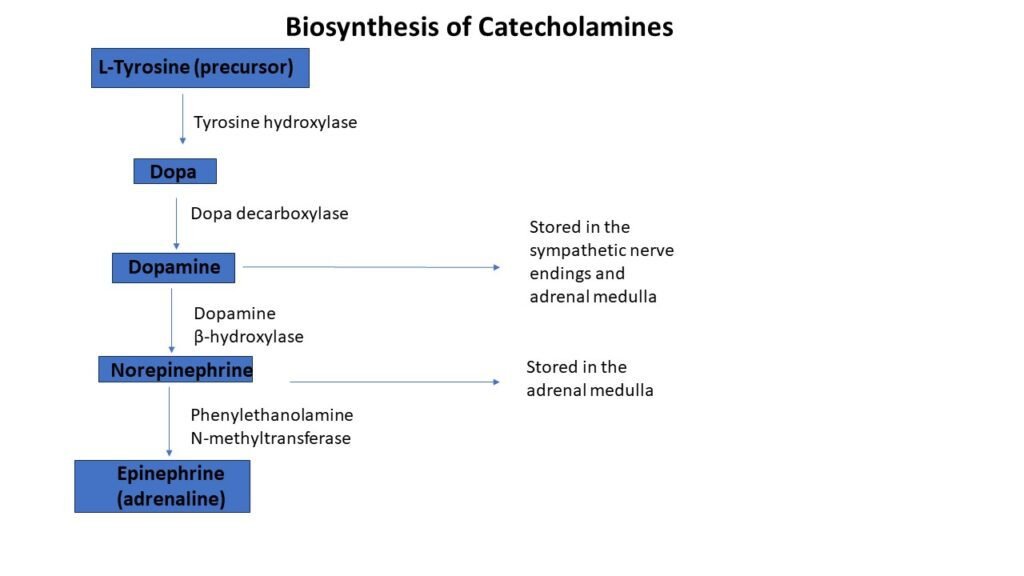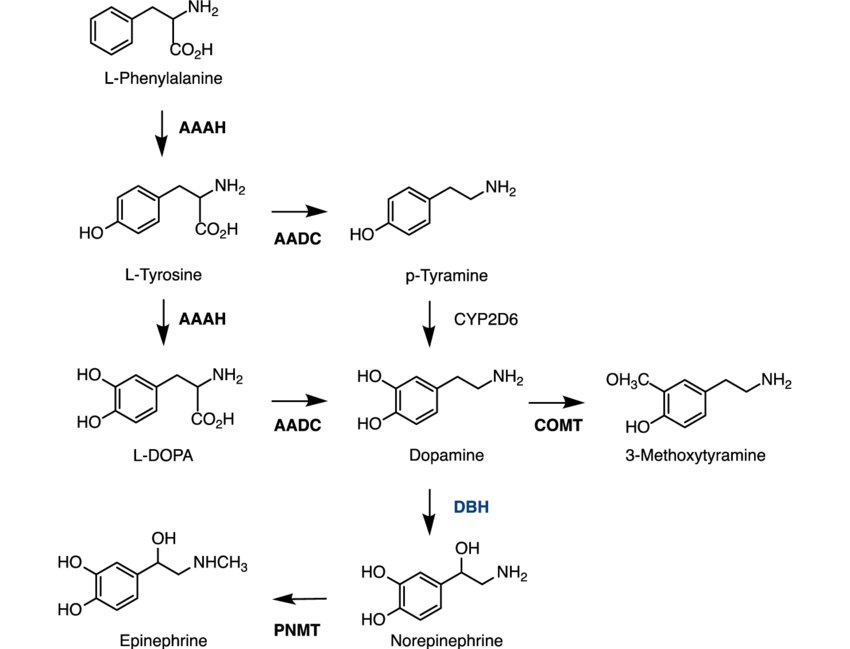Introduction
Catecholamines are the neurotransmitters containing catechol ring with two hydroxyl side groups in their structure. The biosynthesis of catecholamines constitutes a fascinating and intricate processes in human body. Catecholamines including dopamine, norepinephrine, epinephrine are essential neurotransmitter involved in mood regulation, stress response and cardiovascular function. Understanding the biosynthesis of catecholamines is crucial for unravelling their physiological significance, exploring potential therapeutic interventions and gaining insights into disorders related to neurotransmitter imbalance. In this article we will see anatomy of autonomic nervous system, biosynthesis of catecholamines and their catabolism.
Anatomy of autonomic nervous system
Autonomic nervous system (ANS) is the part of peripheral nervous system (PNS) which regulates involuntary physiological processes like heartbeat, blood pressure, respiration, digestion and sexual arousal. The ANS contains three parts i.e. sympathetic nervous system (stimulatory), parasympathetic nervous system (inhibitory) and enteric nervous system.
Autonomic nervous system consists of myelinated pre ganglionic fibre and non-myelinated post ganglionic fibre. The synapse between pre ganglionic fibre and post ganglionic fibre is called as ganglion. The synapse between post ganglionic fibre and receptor is called as neuroeffector junction. The pre ganglionic neurons of sympathetic nervous system have their origin in the thoracic and lumbar vertebrae of the spinal cord. The pre ganglionic neurons of parasympathetic nervous system have their origin in the lower brain – cranium and the sacral portion of the spinal cord. The main neuro-humoral transmitter of parasympathetic system is acetylcholine, hence it also termed as cholinergic system. The main neuro-humoral transmitter of sympathetic system is adrenaline, hence also termed as adrenergic system.
Adrenergic neurotransmitters
The drugs which mimics (produces the similar effects) the action of sympathetic nervous system is known as the sympathomimetic or adrenergic stimulants. Sympathomimetic drugs are of two types, catecholamines and non-catecholamines. On the other hand, drugs which decrease the sympathetic activity are known as the sympatholytic or non-adrenergic drugs. Adrenergic agents act on receptors like norepinephrine (NE, noradrenaline), epinephrine (E, adrenaline) and dopamine (DA) are chemically catecholamine, they are generally organic compound which contain catechol nucleus (ortho-dihydroxy benzene) and ethylamine group.
Biosynthesis of catecholamine (CA)
The catecholamines present in neuroendocrine cells in the form of constant flux. They are continuously synthesized, released and metabolized, so that constant level in the tissue is maintained. The steps involved in biosynthesis of catecholamines and related enzyme inhibitors are given below.
- The first step of biosynthesis of catecholamines involves 3 hydroxylation of acid L-Tyrosine to form levodopa, in the presence of enzyme tyrosine hydroxylase (TH). As TH is the first enzyme in the biosynthetic pathway, TH hydroxylation is the rate limiting step.
- In the second step levodopa is decarboxylated to form dopamine. This reaction is catalyzed by DOPA decarboxylase. This enzyme generally acts on all naturally occurring aromatic L-amino acids hence also known as L-aromatic amino acid decarboxylase (AADC).
- The third step involves side chain beta hydroxylation of dopamine to produce norepinephrine. This reaction take place in the cytoplasm of neuron and catalyzed by dopamine B-hydroxylase (DBH) enzyme. The norepinephrine formed is stored in the vesicles until the process of vesicle fusion.
- The last step in biosynthesis of catecholamine is the N-methylation of norepinephrine to give epinephrine in the adrenal medulla. This reaction is catalyzed by enzyme phenylethanolamines N-methyl transferase (PNMT).

A large amount of norepinephrine is located within synaptic nerve ending and chromaffin cells. After the release the norepinephrine diffuse through intracellular space to bind reversibly adrenoreceptors on effector cells. After the physiological response of norepinephrine, it has to be removed from synapse and terminate its action at the receptors. This process involves two mechanisms.
- Uptake I: 95% of released norepinephrine is removed from synapse. Some part of it metabolized and another transferred into storage vesicles again for use.
- Uptake II: This happens rarely, only when there is high concentration. Part of which released from uptake diffuses out in synapse and metabolized by various pathways.
Catabolism of catecholamines
The metabolism of catecholamines is catalyzed by two main enzymes, monoamine oxidase (MAO) and catechol-o-methyl-transferase (COMT). The noradrenaline is metabolized by both the MAO and COMT enzymes.the end products, vanillyl manadelic acid (VMA) and metanephrines are excreted in the urine. The major role of MAO enzyme is to regulate the amount of noradrenaline stored inside the neurons and major role of COMT is inactivation of circulating catecholamines by methylation.

Summary
The biosynthesis and metabolism of catecholamines involves intricate processes in the production and breakdown of these important neurotransmitters. Catecholamines, including dopamine, norepinephrine and epinephrine plays an important role in the nervous system and various physiological functions. The biosynthesis occurs mainly in the adrenal medulla and nerve terminals. In the process of biosynthesis, the precursor molecules are converted into catecholamines with the help of enzymes. After the release, catecholamines undergo reuptake mechanism and metabolism, mainly in the liver. Understanding the whole processes involved in the biosynthesis and metabolism of catecholamines is essential for the comprehending neurotransmitter regulation, neuroendocrine function and potential therapeutic interventions.
Frequently asked questions
What is vesicle fusion?
Vesicle fusion is the process of merging of vesicles with other vesicles or part of a cell membrane. The increased intracellular concentration of Ca2+ triggers the process of vesicle fusion.
What are chromaffin cells?
A type of cells which makes neurohormones and releases them in the bloodstream are called as chromaffin cells. Chromaffin cells produce epinephrine (adrenaline), norepinephrine (noradrenaline), etc. Chromaffin cells are also known as pheochromocytes or phaeochromocytes.
What are the stages of synthesis of catecholamines?
All catecholamines are synthesized from the precursor L-Tyrosine as follows,
L-Tyrosine –> dopa (dihydroxyphenylalanine) –> dopamine –> norepinephrine (noradrenaline) –> epinephrine (adrenaline).
What is the primary site of biosynthesis of catecholamines?
The biosynthesis occurs mainly in the adrenal medulla and nerve terminals.
What are the 2 enzymes involved in the metabolism of catecholamines?
Two main enzymes involved in the metabolism of catecholamines are monoamine oxidase (MAO) and catechol-o-methyl-transferase (COMT).
What secretes catecholamines?
Chromaffin cells present in the adrenal medulla secretes catecholamines.
For more regular updates you can visit our social media accounts,
Instagram: Follow us
Facebook: Follow us
WhatsApp: Join us
Telegram: Join us
